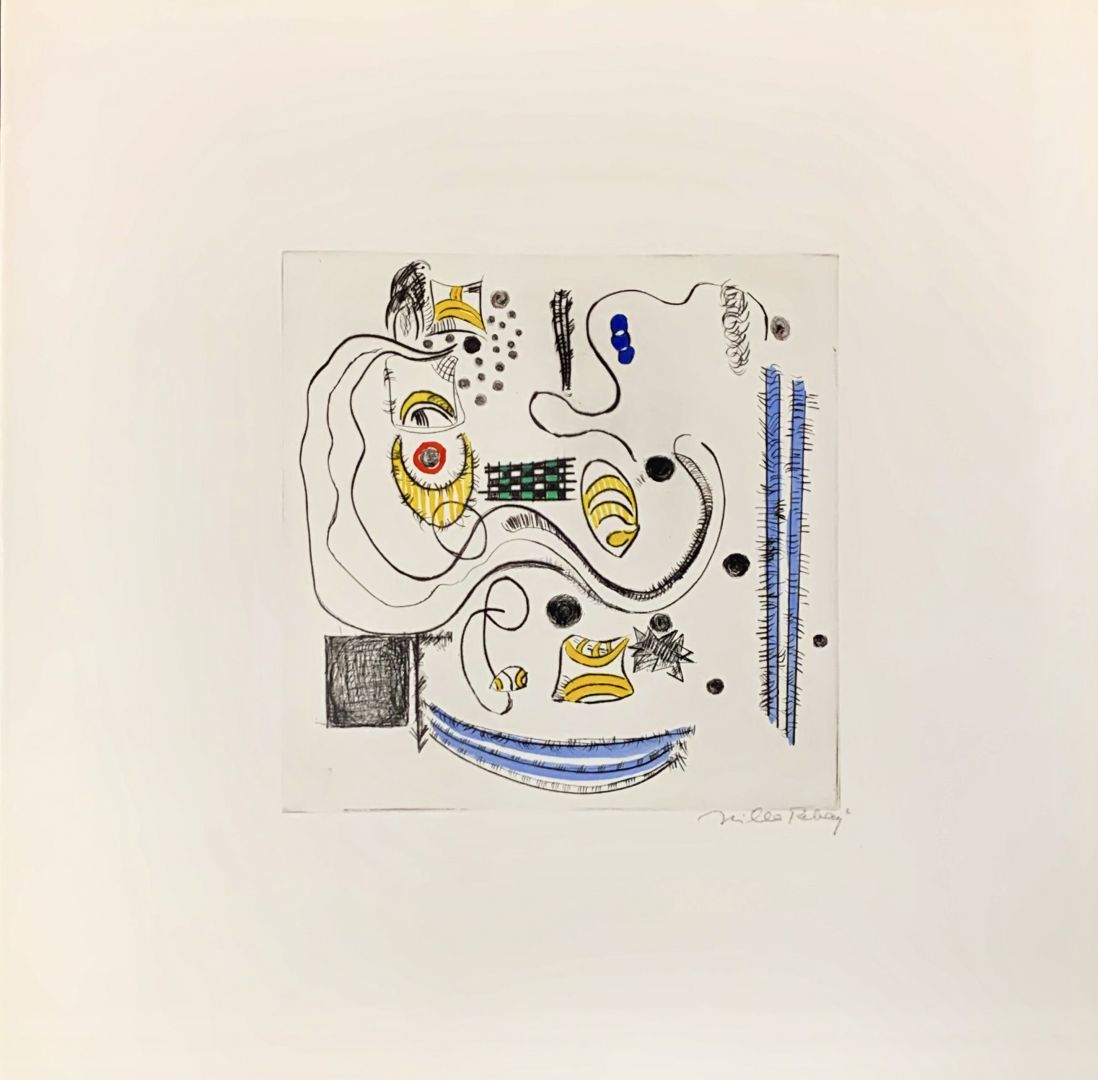Rebay, Hilla. UNTITLED. Etching, with hand-coloring, 1949. Edition size not known. Signed in pencil, and with the artist's monogram and date "49" in reverse within the platemark, printing faintly, lower left. On wove paper. 7 7/8 x 7 7/8 inches (plate), 16 x 16 inches (sheet). In excellent condition.Hilla Rebay (German/American 1890-1967, although a successful artist in her lifetime, is best known now as the original director of the Solomon R. Guggemheim Museum in New York, and, in that capacity, as the person who guided the formation of Solomon Guggenheim's collection of "non-objective" (abstract) art, and who commissioned Frank Lloyd Wright to design the Guggenheim Museum's New York building. Despite falling out with Guggenheim family members after his death, and being forced to resign her positions, she neverthelss bequeathed a substantial part of her own collection, especially works by Kandinsky and Rudolf Bauer, to the Museum.Hilla Rebay was born Baroness Hildegard Anna Augusta Elisabeth Rebay von Ehrenwiesen in 1890 in Strassburg, Germany (now Strasbourg, France). She studied art at the Cologne Kunstgewerbeschule (1908–09), Académie Julian (1909–10), and Académie de la Grande Chaumière (1909–10) in Paris, where she developed into a skilled colorist and excelled at figure and portrait painting. In 1910, she moved to Munich, where she studied under Fritz Erler, Hermann Grõber, and Moritz Heymann. In Munich, she was exposed to modern art, but was not yet interested in the radical art of Der Blaue Reiter and Neue Künstlervereinigung München (NKVM). She exhibited at the Cologne Kunstverein in 1912 and the Salon des Indépendants in Paris in 1913. She then experienced formative periods in Berlin and Zurich in the artistic circles of Hans Richter and Jean Arp, the latter of whom encouraged her to explore motifs reduced to a few basic forms. Arp also gave her copies of the almanac Der Blaue Reiter (1912), which was edited by Vassily Kandinsky and Franz Marc, and Kandinsky's On the Spiritual in Art (1911). From 1915 to 1917, Rebay developed her new non-objective repertoire of painting and collage consisting of colorful overlapping curved lines, planes, and dots; dense textures of slender, asymmetrical shapes; and gently swelling and narrowing lines in countless variations. In the late teens, she exhibited frequently throughout Europe in spaces like Galerie Dada and Galerie Der Sturm and with circles like the Novembergruppe.In 1927, Rebay moved to New York and began exhibiting her work in the US. In 1928, she began her portrait of Solomon R. Guggenheim. As he sat for her in her studio, she introduced him to the ideals of non-objective painting and encouraged him to begin a collection of such painting. By 1929, Rebay facilitated Guggenheim's purchase of works by artists such as Rudolf Bauer, Marc Chagall, Robert Delaunay, Fernand Léger, Laszlo Moholy-Nagy, and Kandinsky. By 1930–31, her idea for a museum, or “temple of non-objectivity,” to house Guggenheim's collection reached its first stage of fruition upon its installation in the collector's suite in the Plaza Hotel. Guggenheim's collection was soon after presented at the Gibbes Memorial Art Gallery (1936 and 1938), Philadelphia Art Alliance (1937), and Baltimore Museum of Art (1939), each with a substantial catalogue and most containing essays by Rebay on the importance of non-objective art.In 1939, the Museum of Non-Objective Painting (renamed the Solomon R. Guggenheim Museum in 1952) opened in Manhattan, with Rebay as its first curator. In addition to presenting exhibitions of non-objective works by European and American artists at the museum, Rebay relentlessly organized traveling exhibitions throughout her tenure at the museum, sending works from the Guggenheim collection to museums, schools, and civic organizations around the country. In 1943, Rebay once again began to make plans for a permanent home for the Guggenheim collection. She considered various architects, eventually contacting Frank Lloyd Wright, whose idealism was similar to her own. She asked Wright for a “temple” or “monument” to the spirit of art. Although the site (at the corner of 89th Street and Fifth Avenue) was finalized in 1944, it took another fifteen years before the museum was finally completed. Rebay organized several important retrospective exhibitions at the Museum of Non-Objectivity on Kandinsky (1945) and Moholy-Nagy (1947). In 1952, Rebay was compelled to resign due to ill health, increasing criticism of her leadership at the museum, and conflicts with its trustees. In 1967, Rebay established and endowed the Hilla von Rebay Foundation to “foster, promote, and encourage the interest of the public in non-objective art.” Rebay died at her home in the Greens Farms hamlet of Westport, Connecticut, in 1967. A comprehensive retrospective of her artwork and her fundamental role in the formation of the museum was held at the Solomon R. Guggenheim Museum in 2005, and has been further explored in the 2009 publication The Museum of Non-Objective Painting Hilla Rebay and the Origins of the Solomon R. Guggenheim Museum. (Biography at https://www.guggenheim.org/artwork/artist/hilla-rebay).
Follow us
Contact Us
ed@edpollackfinearts.com
Copyright © 2025 - Edward T. Pollack Fine Arts





